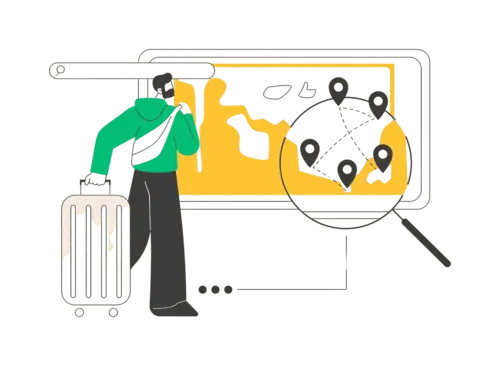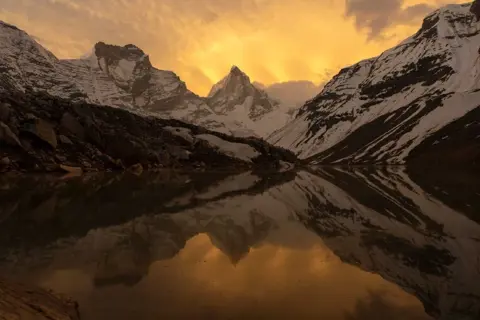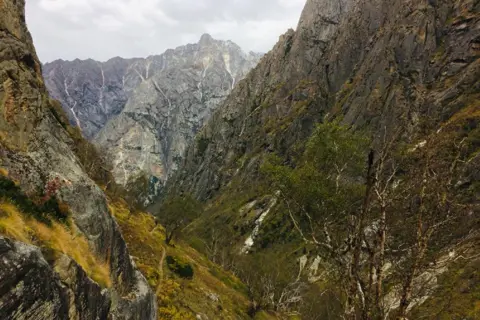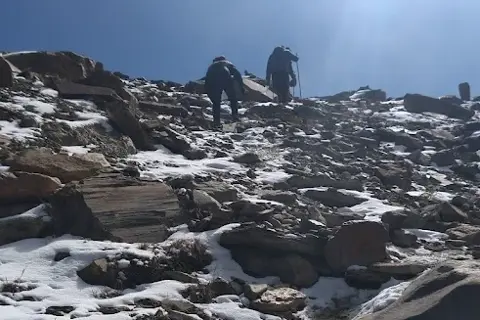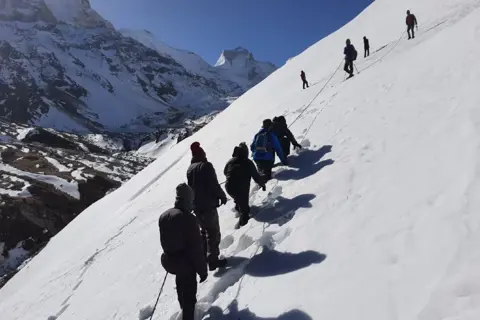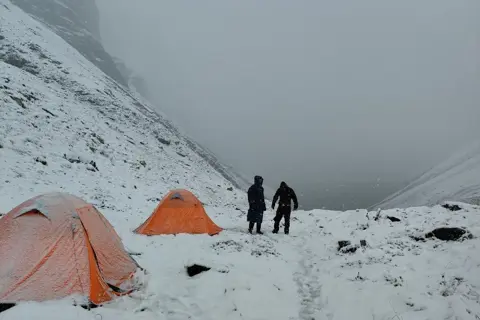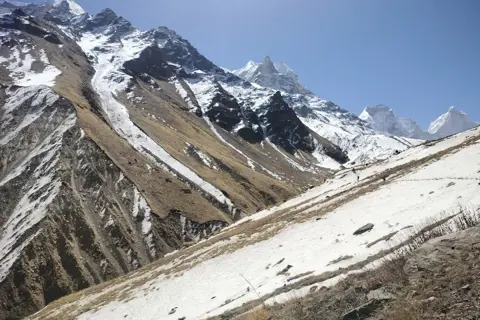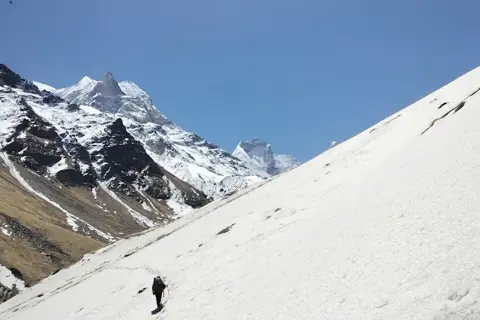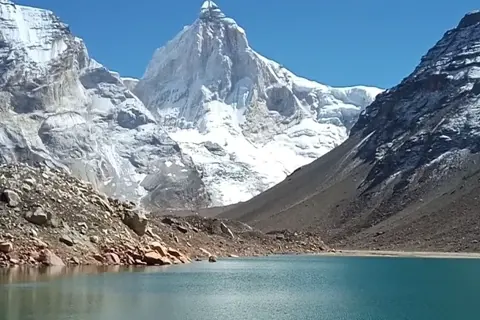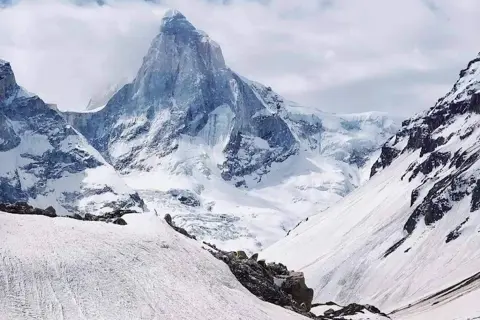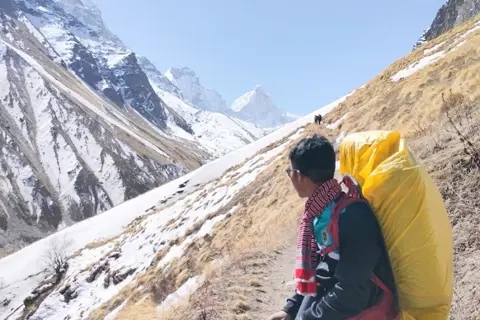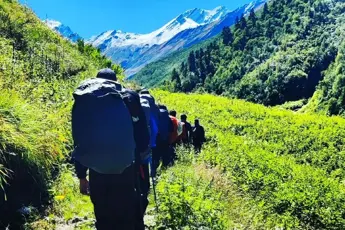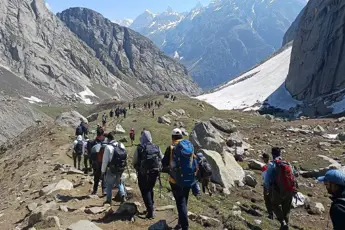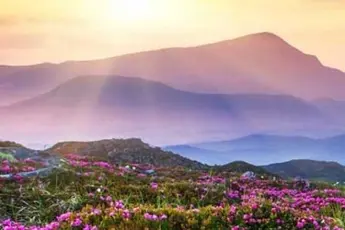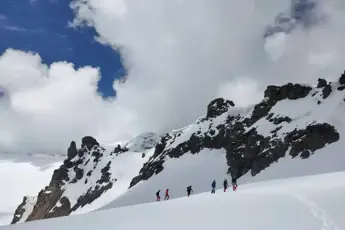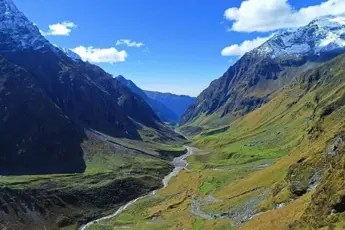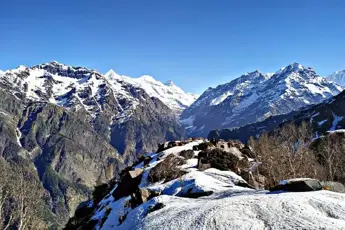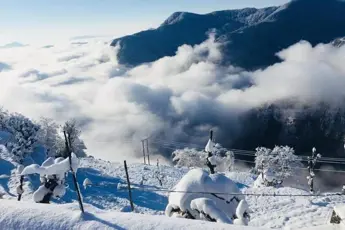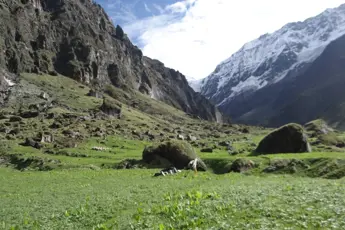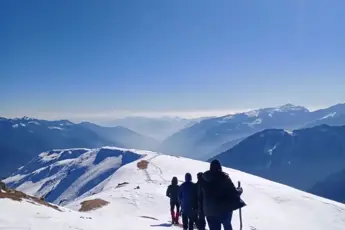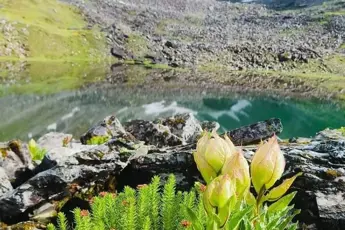This isn’t your average “walk in the park” kinda hike, it’s nuts (in a good way) and tucked deep in the Garhwal Himalayas, Uttarakhand. You’re talking altitude that’ll make your head spin, literally. Kedartal sits up at 4,750 meters, or about 15,580 feet if you’re counting. Locals call it Shiva’s Lake, which sounds pretty epic, right? The whole thing is a puddle made from melting snow off Thalay Sagar and other massive peaks. You start in Gangotri, which is already pretty high up (3,048 meters), and honestly, the place just screams “gateway to adventure.” The actual trek? Well, it’s no joke. You’ll be weaving through pine and birch forests, scrambling up steep rocky bits, and trudging across high-altitude meadows and stony moraines. The vibe shifts fast first, you’re in lush green, then suddenly it’s all barren and wild, like Mother Nature couldn’t decide on one look and just went for all of them.This trek isn’t for people who get winded climbing stairs. You need some legit stamina, not to mention the guts to deal with thin air, rocky trails, and the fact that you’re basically off the grid. Hardly any crowds, no chai stalls every ten meters, just pure, untouched wilderness. That’s kinda the point, though. Sometimes you might spot Himalayan blue sheep (they’re called bharal, but whatever), goral, and if the stars align (and you’re lucky or maybe unlucky, depending on your nerves), maybe a snow leopard lurking around. Sleeping by the glacial lake with a sky full of stars overhead? It’s pure magic, like Instagram can’t even do it justice. Hit it up in May–June or September–October. Monsoon’s a mess, and winter is just asking for trouble. But if you make it, you’ll get more than just killer views, you’ll get a spiritual kick in the soul and stories that’ll make your friends jealous for years. Seriously, Kedartal’s the real deal.History of KedartalWay up in the Garhwal Himalayas, at practically nosebleed altitude, there’s this insane lake called Kedartal Trek. No joke, locals call it Shiva’s Lake, and honestly, if there’s anywhere cosmic vibes are chilling, it’s probably here. The whole scene is wild 4,750 meters up, so forget about a casual afternoon hike unless you’re into gasping for air and existential dread. To folks in Uttarkashi, it’s a big deal, the kind of place that practically demands you have a spiritual epiphany or at least a dramatic Instagram caption. “Kedar” is Lord Shiva’s alter ego, so yeah, it’s got some serious divine branding. People have been coming here for ages, sages, yogis, the original enlightenment hipsters just hanging out by the lake, chasing whatever wisdom they could grab at altitude. Plus, the famous Kedarnath temple is right around the corner, so if you’re a Shiva fanboy or fangirl, you’ll be busy. Back before the selfie-stick invasion, Kedartal was kind of a secret. Only the local Bhotiya and Garhwali folks knew the way, using it for actual religious stuff, not just “finding themselves” for the ‘gram. It was one of those hidden-gem stops during the Char Dham Yatra or trips to Gangotri holy pit stops for the OG pilgrims. Then, bam, the British showed up in the 1800s with their notebooks and explorer hats, acting like they discovered it. Fast forward, and now you’ve got trekkers and climbers drooling over the peaks.That thing’s a monster climbers get weirdly poetic about it, like it’s Everest’s cooler cousin. Bring your A-game if you want to even look at it without feeling judged. If you’re thinking of trekking to Kedartal, don’t even bother unless you’re ready to suffer a little (or a lot). This isn’t your “easy day hike” kind of spot; it’s all cliffs, sketchy glacier bits, and trails that’ll make your thighs scream. But if you’re stubborn (and maybe a bit unhinged), the payoff is nuts. You get those “I’m on top of the world” moments, real deal, not just a screensaver. it’s inside Gangotri National Park, so you’re walking through a nature documentary, except you’re the one sweating. People are finally waking up to the whole “don’t ruin it for everyone else” thing, which, thank god. If you go, don’t be the clown who leaves trash or tries to feed a monkey your chips. Keep it clean. So yeah, Kedartal isn’t just a pretty picture for your phone. It’s got this wild combo of legend, raw nature, and that sweet, sweaty sense of adventure.Nearby Places of Kedartal TrekGangotri: Gangotri’s the OG starting point for the Kedartal trek. It’s not just some random town – it’s sacred, like, people walk for days just to get to the Gangotri Temple and pay respects to Goddess Ganga. The vibe? Pure Himalayan magic, icy peaks everywhere, and that Bhagirathi River just cruising by. Most folks hang around here for a day, partly to catch their breath (hello, altitude), but also to soak up that chill, almost otherworldly energy before heading up to Kedartal.Bhojbasa: Bhojbasa isn’t exactly on the Kedartal trail, but it’s close enough for a little side quest. Right by the Bhagirathi River, this place is straight-up gorgeous – think endless Himalayan views, starry nights, and the kind of peace you only get when you’re miles from anywhere. Trekkers aiming for Gaumukh usually crash here for a bit. If you’ve got the time (and the legs for it), totally worth a detour.Gaumukh Glacier: Gaumukh is the place where the Ganga is born, well, it gushes out of the glacier here, so that counts. It’s got this wild, spiritual pull; you’ll find hardcore trekkers and barefoot pilgrims all in one spot. The hike’s no joke, but the pay-off? Insane views of Mt. Shivling and all those towering Himalayan monsters. If you’re doing Kedartal and have a little extra gas in the tank, this is a must.Tapovan: Tapovan’s like someone took a meadow, cranked up the altitude, and dropped it right next to Mt. Shivling. It’s wild – think golden grass, crazy close-ups of snow-capped peaks, and that rare mix of adventure and zen. People come here for yoga, for meditation, or just to sit and stare. Usually, it’s a Gaumukh thing, but if you’re already haunting the Kedartal area and want a side adventure, go for it.Harsil Valley: About 25 clicks from Gangotri, Harsil’s what you’d call a “hidden gem” if you’re into travel clichés. Apple orchards, pine forests, the Bhagirathi weaving through it’s a straight-up postcard. After the trek, this is where you crash, eat apples, and maybe just exist for a while. It’s quiet, way less touristy than Gangotri, and honestly, kinda magical.Dharali: Dharali’s that blink-and-you houses and more apples than you could ever eat. The place just oozes calm snowy peaks in the background, friendly locals, and zero hustle. If you’re heading back from Kedartal, swing by. It’s worth the extra wander.Best Time to Visit Kedartal TrekSpring (March to May) – Sweet Spot for Chillin’ Outdoors: Spring’s honestly the MVP here. The weather’s just right not too hot, not freezing your butt off. Snow’s finally packing its bags in the mountains, flowers are showing off everywhere, and those trekking trails you’ve been stalking on Instagram? Yeah, they’re finally open for business. If you wanna go sightseeing, hiking, or just mess around outside without dealing with icy toes or rain, this is your season.Summer (June to Mid-July) – High-Altitude Playground: Alright, summer comes in hot (literally), but it’s the golden ticket for those higher-altitude spots. Snow’s pretty much a distant memory up there, so you’re left with rolling green meadows, killer views, and lakes that look like something out of a fantasy movie. Long days, loads of sunshine, perfect if you’re feeling that urge to play mountain goat and hit some legendary Himalayan treks.Monsoon (Mid-July to September) – Green Overload, No Crowds: Trails can get slick, and yeah, landslides are a thing. But if you can dodge the dicey spots, you’re rewarded with Mother Nature showing off big time. Waterfalls are screaming, “take my picture,” and forests go full-on neon green. Plus, the usual tourist swarm, it’s just you, the rain, and some peace. Just stick to the safer, lower-altitude spots, unless you’re into adrenaline-fueled mudslides.Autumn (October to November) – Postcard Material Everywhere: This is the season that makes you want to write poetry or, at minimum, spam your friends with landscape pics. The skies? Clear as a bell. The mountains? Looking sharp. Air’s crisp, not cold, and there’s a post-monsoon freshness that’s hard to beat. Festivals pop up left and right, so you might catch a celebration or two while you’re out trekking or soaking in the views. Honestly, can’t go wrong.Winter (December to February) – Snow Bunnies Rejoice: Winter’s for the folks who want snow up to their knees and don’t mind the cold slapping them in the face. Some treks turn into a snowy dreamscape, perfect if you’re into snowball fights or just want to pretend you’re in a fairytale.How to Reach Kedartal TrekBy Airport: You’ll hit the tarmac at Jolly Grant Airport in Dehradun, it’s miles (like 250 km, no joke) from Gangotri, where all the real adventure goes down. Once you land, snag a taxi if you’re feeling bougie, or just shove your way onto a bus headed for Uttarkashi. Stick with it, keep moving, and bam, you’ll land in Gangotri.By Railaway Station: If trains are your thing, Dehradun Railway Station is the way to go. You’ve got options: Delhi, Haridwar, Rishikesh, wherever. Once you roll in, it’s road trip central. Grab a lift, roll through Uttarkashi, and just keep going till you hit Gangotri. Doesn’t get much simpler.By Road: Gangotri isn’t exactly playing hide-and-seek; you can cruise up from Rishikesh, Dehradun, or Haridwar. State-run buses, shared jeeps, private cabs, take your pick. The road dead-ends at Gangotri, so when you run out of asphalt, congrats, you’re there. That’s your cue to lace up those boots and start hustling toward Kedartal.Why Book with escape2exploreWhen exploring the Kedartal Trek from Bengaluru and beyond, escape2explore stands out as a trusted name in adventure and experiential travel. Here’s why hundreds of travellers choose us for their getaways:Trusted, Well-Reviewed Local Operator: escape2explore has gained the trust of thousands of content tourists all over India. With persistent positive feedback and an unblemished reputation for delivering quality experiences, we assure you that your experience will be hassle-free, memorable, and value-packed. Our insider local knowledge guarantees that you will always be in safe hands.Seasoned Guides: Our trips are led by friendly, trained, and professional guides who are passionate about the outdoors and your safety. Whether it's a beach trek, a cultural tour, or a spiritual walk through temples, our team knows the terrain, the stories, and how to make each moment count.Safe & Curated Itineraries: Your safety is our number one priority. Our tour packages are thoughtfully crafted with safety measures, researched accommodations, and easy travel arrangements. We take care of the details so you can have the experience hassle-free and worry-free.Unique Experience That You Won't Find Anywhere Else: With escape2explore, you discover more than the tourist attractions. We go off the beaten track with hidden beaches, unusual treks, offbeat cultural destinations, and true interactions.





